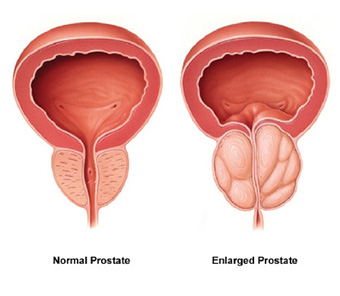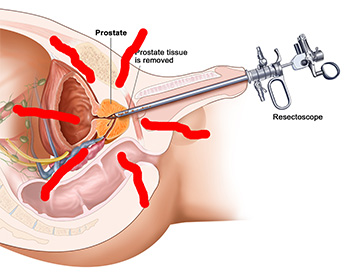INTRODUCTION
The prostate is a small gland that is part of the male reproductive system. It sits just below the bladder (the organ that stores urine) and in front of the rectum (the organ which is the lowermost portion of your gut and which stores your motion) the prostate is normally about the size of a walnut.

PROSTATE DISEASES
1. BPH (Benign Prostatic Hyperplasia) – occurs in old age.
2. Carcinoma prostate – cancer within the prostate.
Of these BPH is more common.
What is BPH?
Benign prostatic hyperplasia is a condition that occurs when the prostate gland enlarges, potentially slowing or blocking the urine stream.Other names for benign prostatic hyperplasia include benign prostatic hypertrophy, an enlarged prostate, and BPH. BPH occurs only in men; approximately 8 percent of men aged 31 to 40 have BPH. In men over age 80, more than 80 percent have BPH.
Symptoms
The symptoms of BPH usually begin after age 50.The most common symptoms of BPH include:
- Frequent urination, especially at night
- A hesitant, interrupted, or weak stream of urine
- Urgency
- Leaking or dribbling of urine
- Sense of incomplete emptying
What should I do if I get any of the above symptoms?
You should immediately seek medical attention. Your doctor may perform some basic tests on you like urine and blood tests.He might also order an ultrasound of the abdomen and uroflowmetry.
What will be the treatment options?
There are two ways by means of which you may be treated. One is by medication i.e. tablets which improve the urine flow.The second way is by surgery which is usually advised when the medication becomes ineffective or in other special situations.
What is the surgical option?
The surgery which is commonly performed is TURP (transurethral resection of prostate). In this procedure, a small instrument is introduced via the natural urinary opening and the prostate is removed by cutting it into small chips. It’s a purely endoscopic procedure. Minimum of 4 days of hospital stay is required. The patient can return to work 4 days after returning home. He has to avoid strenuous activities for one month.

What is prostate cancer and what are its treatment options?
Cancer can affect the prostate.It is common above the age of 50. The usual symptoms are difficulty in passing urine, incomplete emptying of urine and slow stream of urination. Your doctor will diagnose prostate cancer by means of a blood test called PSA, MRI scan and by a biopsy (a small bit of prostate will be removed and sent for a lab test). Further treatment depends on the symptoms, stage of the disease, age and comorbidities. Treatment options may vary from surgery to medicines to radiation therapy.
How to solve prostate disease
Prostate disease is a common condition that affects many men, particularly as they age. There are different types of prostate disease, including prostatitis, benign prostatic hyperplasia (BPH), and prostate cancer. The treatment options for prostate disease depend on the specific condition, but here are some general tips for managing prostate disease:
Medications
There are several medications available to treat prostate disease, depending on the specific condition. For prostatitis, antibiotics may be prescribed to treat any underlying bacterial infection. For BPH, medications such as alpha-blockers or 5-alpha-reductase inhibitors may be prescribed to help relax the muscles in the prostate gland and reduce its size. For prostate cancer, treatment options may include chemotherapy, radiation therapy, hormone therapy, or surgery.
Lifestyle Changes
Making certain lifestyle changes can also help manage prostate disease. Eating a healthy diet that is low in saturated and trans fats and high in fruits, vegetables, and whole grains may help reduce the risk of prostate cancer. Regular exercise can also help reduce the risk of prostate cancer and improve overall prostate health. Kegel exercises, which involve contracting and relaxing the muscles that control urination, can also help improve urinary function and reduce symptoms of BPH.
Minimally Invasive Procedures
For some types of prostate disease, such as BPH, minimally invasive procedures may be an option. These procedures can help reduce the size of the prostate gland and alleviate symptoms. Procedures such as transurethral resection of the prostate (TURP), transurethral microwave thermotherapy (TUMT), and laser therapy may be used to treat BPH.
Surgery
In some cases, surgery may be necessary to treat prostate disease. For example, if medications or minimally invasive procedures are not effective in treating BPH, surgery to remove part of the prostate gland may be necessary. For prostate cancer, surgery to remove the prostate gland, known as a radical prostatectomy, may be recommended.
Watchful Waiting
In some cases, particularly for older men with BPH or low-risk prostate cancer, watchful waiting may be recommended. This involves monitoring the condition over time and only starting treatment if symptoms worsen or the condition progresses.
It is important to note that the treatment options for prostate disease depend on the specific condition and the individual’s overall health. It is important to work with a hospital to develop a personalized treatment plan that takes into account the individual’s needs and preferences.
In conclusion, there are several ways to manage prostate disease, including medications, lifestyle changes, minimally invasive procedures, surgery, and watchful waiting. It is important to work with the best hospital to develop a personalized treatment plan that takes into account the specific condition and the individual’s overall health. Making lifestyle changes, such as eating a healthy diet and exercising regularly, can also help improve overall prostate health and reduce the risk of prostate disease.If you looking to solve prostate disease in erode ? Contact the best hospital ( kalyani kidney center ) for your disease.
FAQ of Prostate disease and how to prevent it
Prostate disease is a condition that affects the prostate gland, a small gland located below the bladder in men. There are different types of prostate disease, including prostatitis, benign prostatic hyperplasia (BPH), and prostate cancer.
The symptoms of prostate disease can vary depending on the specific condition. For prostatitis, symptoms may include pain or discomfort in the pelvic area, frequent urination, and difficulty urinating. For BPH, symptoms may include urinary urgency, weak urine flow, and difficulty starting urination. For prostate cancer, early-stage prostate cancer may not cause any symptoms, but as the cancer progresses, symptoms may include difficulty urinating, blood in the urine, and bone pain.
Prostate disease is typically diagnosed through a combination of a physical exam, blood tests, and imaging tests, such as an ultrasound or MRI. A biopsy may also be done to confirm a diagnosis of prostate cancer.
While there is no guaranteed way to prevent prostate disease, there are certain lifestyle changes that may help reduce the risk. Eating a healthy diet that is low in saturated and trans fats and high in fruits, vegetables, and whole grains may help reduce the risk of prostate cancer. Regular exercise can also help reduce the risk of prostate cancer and improve overall prostate health. Kegel exercises, which involve contracting and relaxing the muscles that control urination, can also help improve urinary function and reduce symptoms of BPH.
Treatment for prostate cancer depends on the stage of the cancer and the individual's overall health. Treatment options may include surgery to remove the prostate gland, radiation therapy, hormone therapy, chemotherapy, or a combination of these. In some cases, watchful waiting may be recommended, particularly for older men with low-risk prostate cancer.
While there is no cure for BPH, there are several treatment options available to alleviate symptoms. Medications such as alpha-blockers or 5-alpha-reductase inhibitors may be prescribed to help relax the muscles in the prostate gland and reduce its size. Minimally invasive procedures, such as TURP or laser therapy, may also be used to treat BPH.
While there is no one cause of prostate disease, there is some evidence to suggest that genetics may play a role. Men with a family history of prostate cancer may be at a higher risk of developing the disease themselves.
Prostate disease: what are the treatment options?
Prostate disease encompasses a range of conditions that affect the prostate gland, including prostatitis, benign prostatic hyperplasia (BPH), and prostate cancer. Treatment options depend on the specific condition, the stage of the disease, and the individual’s overall health. Here are some common treatment options for prostate disease:
Medications
Medications may be prescribed to manage symptoms or treat the underlying cause of prostate disease. For prostatitis, antibiotics may be prescribed to treat bacterial infections. For BPH, medications such as alpha-blockers or 5-alpha-reductase inhibitors may be prescribed to help relax the muscles in the prostate gland and reduce its size. For prostate cancer, treatment may involve hormone therapy or chemotherapy drugs.
Minimally Invasive Procedures
For BPH, minimally invasive procedures may be an option to reduce the size of the prostate gland and alleviate symptoms. Procedures such as transurethral resection of the prostate (TURP), transurethral microwave thermotherapy (TUMT), and laser therapy may be used to treat BPH. These procedures involve using heat or energy to destroy excess prostate tissue.
Surgery
For some cases of prostate disease, surgery may be necessary. For example, if medications or minimally invasive procedures are not effective in treating BPH, surgery to remove part of the prostate gland may be necessary. For prostate cancer, surgery to remove the prostate gland, known as a radical prostatectomy, may be recommended.
Radiation Therapy
It is commonly used to treat localized prostate cancer, and may be used in combination with other treatments. Radiation therapy can be given externally or internally, using radioactive seeds implanted in the prostate gland.
Watchful Waiting
For older men with low-risk prostate cancer or those with slow-growing tumors, watchful waiting may be recommended. This involves monitoring the condition over time and only starting treatment if symptoms worsen or the condition progresses. This approach avoids the potential side effects of more aggressive treatments, while still allowing for treatment if necessary.
Active Surveillance
For older men with low-risk prostate cancer or those with slow-growing tumors, watchful waiting may be recommended. This involves monitoring the condition over time and only starting treatment if symptoms worsen or the condition progresses. This approach avoids the potential side effects of more aggressive treatments, while still allowing for treatment if necessary.
Active surveillance is a more active form of watchful waiting, in which regular tests, such as blood tests and biopsies, are done to monitor the progression of prostate cancer. Treatment is only initiated if the cancer shows signs of growing or spreading.
In conclusion, treatment options for prostate disease depend on the specific condition and the individual’s overall health. Medications, minimally invasive procedures, surgery, radiation therapy, and watchful waiting or active surveillance may all be viable options for treating prostate disease. It is important to work with abbest hospital like Kalyani kidney center to develop a personalized treatment plan that takes into account the individual’s needs and preferences.


